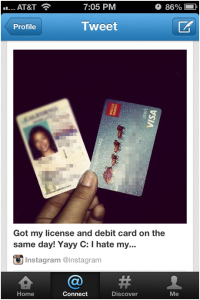In a recent study about cell phone use by the Pew Internet and American Life project, 82% of respondents said they use their phone to take pictures and 80% use it to send or receive text messages. These were by far the most popular uses of phones; in a distant 3rd place was accessing the Internet, which 56% of responded said they did.
While the study was done on people over the age of 18, it’s not hard to assume similar trends and attitudes among young people, too. According to Pew, over 75% of teens own a cell phone and half of them send an average of 1500 text messages a month.
For those of us who have them, we love our cell phones.
From Good Sharing to Oversharing
Facebook’s growth and global reach proves that we love sharing things with others, probably as much as we love using our cell phones. The only thing we may love more than either of these is doing them both.
It’s so easy to do with mobile social networking apps like Facebook, Twitter, Instagram, and Tumblr. The fact that we can capture something we’ve seen and need to share immediately with our friends and family is an amazing ability. One tap and you have a picture. One more and you have a massive audience for it.
Take Hurricane Sandy, for example. Instagram, the photo-sharing app that functions much like Twitter and Facebook, logged around 1.3 million photos tagged with the word #sandy. These were images taken by the public and shared with the world, so the rest of us could see what was happening, up close and in near real-time.
It will go down as another shining example of social media’s usefulness and power to do good.
But the same tools can be misused, to the detriment of the person using it.
Our researchers have been tracking a current trend among youth around the world taking photos of their new driver’ s licenses or new credit or debit cards and posting them online for all to see. Account numbers and home addresses are clearly shown. We’ve blurred them in these photos, but you might find many online just by doing a quick search.
s licenses or new credit or debit cards and posting them online for all to see. Account numbers and home addresses are clearly shown. We’ve blurred them in these photos, but you might find many online just by doing a quick search.
These users have made it very easy for people who might have less than good intentions, like identity thieves, stalkers, and other criminals to do their crimes.
We can’t yet be sure this is a massive trend – we certainly hope not – but it is a risky behavior. It’s another example of why we need to guide young people about safe, responsible technology use before we give it to them.
The concept of over-sharing is not new. The website pleaserobme.com highlighted the bad judgment by social media users, when they publicly posted information letting people know where they physically were, through location services like Foursquare, for example. (The site no longer showcases people’s public posts, but the URL does exist to raise awareness and educate people about the risks of over-sharing.)
We’re social animals. We want to share. We want to shout our good news aloud, whether it’s about a new driver’s license, new job, new baby, or 25-pound turkey we just cooked. And we want to be acknowledged and congratulated for it. This is understandable. It’s human.
But we’ve got to consider what we’re sharing and who we’re sharing it with. We’ve got to understand and help our kids know how to distinguish between what is or isn’t ok to share. Here’s some guidance you can give your kids, perhaps before they get their new cell phone this holiday:
- Know and follow the rules. All of these social media sites require their users to be at least 13. If you’re not yet 13, you’ll need to wait. If you have a child under 13 with a smart phone or other device that uses apps, consider turning on the restrictions that will prevent them from using apps that are age-appropriate. (For iOS devices, this is under Settings>General>Restrictions and is password-protected.)
- Assume anything you post is public. Think before you share it, even if it’s just to a one person. Like a secret, they can still share it with others. Only take and share photos you wouldn’t mind everyone seeing.
- Use privacy settings. The major social sharing mobile apps like Instagram, Facebook, and Twitter all have them. Turn them on so that only the people you allow can see your photos.
- Be a minimalist. Say only what you need to say, even to those you already know and trust. Share it with only those you need to share it with.
- Be alert about the people who follow or friend you. It’s best to share photos only with those you know. Ignore friend or follow requests from those you don’t know.
- Turn off geo-location on your camera. Phone cameras use an identifier that pinpoints exactly where you physically took a photo. You can turn this tagging off by turning off the geo-location feature associated with the phone.
- Be a good citizen. Don’t take pictures of others to ridicule or harm them. Treat them the way you’d want to be treated. Be considerate. If they don’t want you to share a photo that includes them, respect their privacy.
Here’s a list of links on safe social sharing from some of the major social networks:
- Facebook: http://www.facebook.com/safety/groups/parents/
- Flickr: http://in.safely.yahoo.com/flickr-safety-guide-000000241.html
- Instagram’s Tips for Parents: http://help.instagram.com/customer/portal/articles/615900-tips-for-parents
- Twitter: http://support.twitter.com/articles/470968-safety-tips-for-parents#
Here’s a list of organizations and sites for more tips on helping kids use technology safely and responsibly:
- Trend Micro’s Internet Safety for Kids & Families program – http://internetsafety.trendmicro.com
- ConnectSafely – www.connectsafely.org
- Common Sense Media – www.commonsensemedia.org
- iKeep Safe Coalition – www.iKeepSafe.org
Lynette Owens is Global Director of Trend Micro’s Internet Safety for Kids and Families (ISKF) program. As a pro-technology parent and Internet safety advocate, Lynette spends most of her time raising awareness and educating the public about the safe and responsible use of the Internet, recruiting fellow employee volunteers to get involved around the world, or volunteering her own time in her community. For more on Lynette see: /internet-safety/our-bloggers/
Or follow Lynette on Twitter @lynettetowens
Lynette Owens is Vice President of Consumer Education & Marketing at Trend Micro and Founder of the company's signature Internet Safety for Kids and Families program. With 30+ years in the tech industry, Lynette oversees global initiatives to help deliver the technology tools and education that people of all ages need to keep themselves and their families safe online. She serves on the advisory boards of the Identity Theft Resource Center's Alliance for Identity Resilience, the Global Anti-Scam Alliance, and INHOPE.

